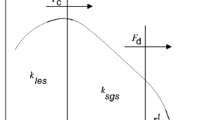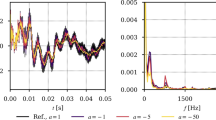Abstract
Numerical simulation is used in this article to study the structure and dynamics of a spatially growing reactive mixing layer. It is assumed in this analysis that the chemistry is infinitely fast and that it may be modeled by a single-step irreversible reaction. The analysis also relies on thermodiffusive approximation in which the heat released by the chemical reaction does not influence the flow. Calculations performed for a range of values of the global equivalence ratio indicate how the flame evolves as a function of the chemical composition of the two streams. Results of simulations are compared with those of a local model describing the flame elements (the flamelets) that form the flame. Analysis of the fuel consumption rate along the flame sheet indicates that the description of the reactive mixing layer must account for two basic processes. In regions where the reactive surface is isolated, the reaction rate is determined by the local strain rate acting in the plane tangent to the flame. In regions where the flame is rolled-up by the large-scale vortices, it is found that the reaction rate is significantly reduced because the flame elements come close together and interact strongly. Mutual annihilation of the neighboring elements takes place in these circumstances. These two mechanisms, initially proposed by Marble and Broadwell to describe turbulent diffusion flames, are well supported by this simulation. Results of calculations are also used to determine the distributions of mean flame surface density and mean mass fractions. These mean quantities are compared with those determined with a physical model of the turbulent reactive flow. The model is based on a balance equation for the mean flame surface density in combination with a local description in terms of strained flame elements. The agreement obtained indicates that the controlling processes are modeled correctly.
Similar content being viewed by others
References
Batchelor, G.K. (1967). An Introduction to Fluid Mechanics. Cambridge University Press, Cambridge.
Bilger, R.W. (1976). Turbulent jet diffusion flames. Progr. Energy Combust. Sci., 1, 109–130.
Bilger, R.W. (1988). The structure of turbulent nonpremixed flames. Proceedings of the Twenty-Second Symposium (International) on Combustion. The Combustion Institute, Pittsburgh, pp. 475–488.
Blottner, F.G. (1981). Introduction to Computational Techniques for Boundary Layers. Report No. SAND79-0893.
Boris, J.P., and Oran, E.S. (1987). Numerical Simulation of Reactive Flow. Elsevier, New York.
Braza, M. (1986). Analyse physique du comportement dynamique d'un écoulement externe, décollé, instationnaire en transition laminaire-turbulente. Doctoral Thesis, Institut National Polytechnique de Toulouse.
Brown, G.L., and Roshko, A. (1974). Large scales in the developing mixing layer. J. Fluid Mech., 64, 775–816.
Candel, S.M., and Poinsot, T. (1990). Flame stretch and the balance equation for the flame area. Combust. Sci. Technol., 70, 1–15.
Candel, S., Veynante, D., Lacas, F., Maistret, E., Darabiha, N., and Poinsot, T. (1991). Coherent flame model: applications and recent extensions. In Advances in Combustion Modeling (B. Larrouturou, ed.). World Scientific, Singapore, pp. 19–64.
Carrier, G.F., Fendell, F.E., and Marble, F.E. (1975). The effect of strain rate on diffusion flames. SIAM J. Appl. Math., 28, 463–500.
Chang, C.H.H., Dahm, W.J.A., and Tryggvason, G. (1991). Lagrangian model simulations of molecular mixing, including finite rate chemical reactions, in a temporally developing shear layer. Phys. Fluids A, 3, 1300–1311.
Chorin, A.J. (1968). A numerical method for solving incompressible viscous flow problems. J. Comput. Phys., 2, 12–26.
Ciment, M., Leventhal, S.H., and Weinberg, B.C. (1978). The operator compact implicit method for parabolic equations. J. Comput. Phys., 28, 135–166.
Clavin, P. (1985). Dynamic behavior of premixed flame fronts in laminar and turbulent flows. Progr. Energy Combust. Sci., 11, 1–59.
Darabiha, N., and Candel, S. (1992). The influence of the temperature on extinction and ignition limits of strained hydrogen—air diffusion flames. Combust. Sci. Technol., 86, 67.
Delhaye, J.M., and Achard, J.L. (1978). On the averaging operators introduced in two-phase flow. In Proceedings of the CSW NI Specialists Meeting (S. Banerjee and K.R. Weawer, ed.). AECL, pp. 5–84.
Dimotakis, P.E., and Brown, G.L. (1976). The mixing layer at high Reynolds number: large structure dynamics and entrainment. J. Fluid Mech., 78, 585–560.
Ghoniem, A.F., and Givi, P. (1988). Lagrangian simulation of a reacting mixing layer at low heat release. AIAA J., 26, 690–697.
Givi, P., Jou, W.H., and Metcalfe, R.W. (1986). Flame extinction in a temporally developing mixing layer. Proceedings of the Twenty-First Symposium (International) on Combustion. The Combustion Institute, Pittsburgh, pp. 1251–1261.
Grinstein, F.F., and Kailasanath, K. (1992). Chemical energy release and dynamics of transitional reactive shear flows. Phys. of Fluids A, 10, 2207–2221.
Hermanson, J.C., and Dimotakis, P.E. (1989). Effects of heat release in a turbulent, reacting shear layer. J. Fluid Mech., 199, 333–375.
Ho, C.M., and Huang, J.S. (1982). Subharmonics and vortex merging in mixing layers. J. Fluid Mech., 119, 443–473.
Karagozian, A.R., and Marble, F.E. (1986). Study of a diffusion flame in a stretched vortex. Combust. Sci. Technol., 45, 65–84.
Koochesfahani, M.M., and Dimotakis, P.E. (1986). Mixing and chemical reactions in a turbulent liquid mixing layer. J. Fluid Mech., 179, 83–112.
Koochesfahani, M.M., Dimotakis, P.E., and Broadwell, J.E. (1985). A “Flip” experiment in a chemically reacting turbulent mixing layer. AIAA J., 8, 1191–1194.
Kourta, A., Braza, M., Chassaing, P., and Ha Minh, H. (1987). Numerical analysis of a natural and excited mixing layer. AIAA J., 25, 279–286.
Laverdant, A.M., and Candel, S. (1989). Computation of diffusion and premixed flames rolled up in vortex structures. J. Propul. Power, 5, 134–143.
Mahalingham, S. (1989). Non-premixed combustion: full numerical simulation of a coflowing axisymmetric jet, inviscid and viscous stability analysis. Doctoral Thesis, Stanford University, Stanford.
Marble, F., and Broadwell, J.E. (1977). The Coherent Flame Model for Turbulent Chemical Reactions. Report No. TRW-9-PU, Project SQUID.
McMurtry, P.A., and Givi, P. (1989). Direct numerical simulations of mixing and reaction in a nonpremixed homogeneous turbulent flow. Combust. Flame, 77, 171–185.
McMurtry, P.A., Jou, W.H., Riley, J.J., and Metcalfe, R.W. (1986). Direct numerical simulations of a reacting mixing layer with chemical heat release. AIAA J., 24, 962–970.
Mungal, M.G., and Dimotakis, P.E. (1984). Mixing and combustion with low heat release in a turbulent shear layer. J. Fluid Mech., 148, 349–382.
Mungal, M.G., and Frieler, C.E. (1988). The effects of Damköhler number in a turbulent shear layer. Combust. Flame, 71, 23–34.
Mungal, M.G., Hermanson, J.C., and Dimotakis, P.E. (1985). Reynolds number effects on mixing and combustion in a reacting shear layer. AIAA J., 23, 1418–1423.
Nomura, K.K., and Elghobashi, S.E. (1992). Mixing characteristics of an inhomogeneous scalar in isotropic and homogeneous sheared turbulence. Phys. Fluids A, 4, 606–625.
Peters, N. (1983). Local quenching due to flame stretch and non-premixed combustion. Combust. Sci. Technol., 30, 1–17.
Peters, N. (1986). Laminar flamelets concepts in turbulent combustion. Proceedings of the Twenty-First Symposium (International) on Combustion. The Combustion Institute, Pittsburgh, pp. 1231–1250.
Poinsot, T., Veynante, D., and Candel, S. (1990). Diagrams of premixed turbulent combustion based on direct simulation. Proceedings of the Twenty-Third Symposium (International) on Combustion. The Combustion Institute, Pittsburgh, pp. 613–619.
Riley, J. J., Metcalfe, R.W., and Orszag, S.A. (1986). Direct numerical simulations of chemically reacting turbulent mixing layers. Phys. Fluids, 29, 406–422.
Saffman, P.G., and Milinazzo, F. (1976). Turbulence model predictions for the inhomogeneous mixing layer. Stud. Appl. Math., 55, 45–63.
Savas, O., and Gollahalli, S.R. (1986). Flow structure in near-nozzle region of gas jet flames. AIAA J., 24, 1137–1140.
Veynante, D., Candel, S., and Martin, J.P. (1987). Coherent flame modelling of chemical reaction in a turbulent mixing layer. In Complex Chemical Reactions (J. Warnatz and W. Jager, eds.). Springer-Verlag, Berlin, pp. 386–398.
Veynante, D., Lacas, F., and Candel, S. (1989). A new flamelet combustion model combining premixed and non-premixed turbulent flames. AIAA Paper 89-0487. Also (1991) AIAA J., 29, 848–851.
Wallace, A.K. (1981). Experimental investigation of the effects of chemical heat release in the reacting turbulent plane shear layer. Doctoral Thesis, University of Adelaide.
Williams, F.A. (1985). Combustion Theory. Cummings, Menlo Park, CA.
Winant, C.D., and Browand, F.K. (1974). Vortex pairing in the mechanism of turbulent mixing layer growth at moderate low number. J. Fluid Mech., 63, 237–255.
Author information
Authors and Affiliations
Additional information
Communicated by Ashwani Kapila
This research was partially supported by DRET.
Rights and permissions
About this article
Cite this article
Delhaye, B., Veynante, D., Candel, S.M. et al. Simulation and modeling of reactive shear layers. Theoret. Comput. Fluid Dynamics 6, 67–87 (1994). https://doi.org/10.1007/BF00312342
Received:
Accepted:
Issue Date:
DOI: https://doi.org/10.1007/BF00312342




